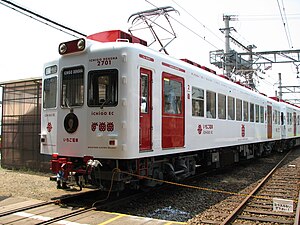Kishigawa Line
| Kishigawa Line | |||
|---|---|---|---|
 "Ichigo EC" trainset designed by Eiji Mitooka | |||
| Overview | |||
| Owner | Wakayama Electric Railway | ||
| Locale | Wakayama | ||
| Stations | 14 | ||
| Technical | |||
| Line length | 14.3 km (8.9 mi) | ||
| Track gauge | 1,067 mm (3 ft 6 in) | ||
| Electrification | 1,500 V DC overhead catenary | ||
| Operating speed | 60 km/h (37 mph) | ||
| |||
The Kishigawa Line (貴志川線, Kishigawa-sen) is a railway line in Wakayama Prefecture, Japan. It is the sole line of Wakayama Electric Railway Co., Ltd. The 14.3 km route extends from Wakayama Station in the city of Wakayama to Kishi Station in neighboring Kinokawa. Including the terminals, the Kishigawa Line has 14 stations. Its gauge is 1,067 mm (3 ft 6 in). The line is single-track and electrified at 1,500 V DC. Prior to April 1, 2006, the line was part of the Nankai Electric Railway system.
History
The Sando Light Railway Co. opened the Wakayama - Sando section between 1916 and 1917, and extended the line to Kishi in 1933.
The line was electrified at 600 VDC between 1941 and 1943, and was acquired by the Nankai Electric Railway Co. in 1961.
CTC signalling was commissioned in 1993, and the Wakayama Electric Railway Co. acquired the line in 2006, increasing the line voltage to 1500 VDC in 2012.
Rolling stock and service
The Kishigawa Line uses 6 sets (12 cars) of 2270 series electric multiple units (EMUs), originally built for Nankai and transferred to the new operator together with the tracks and other assets of the Kishigawa Line. Some of the cars have been repainted with the design by industrial designer Eiji Mitooka, who designed the type 9200 "MOMO" tram of Okayama Electric Tramway and trains of JR Kyushu including the 800 Series Shinkansen while others are still in the Nankai livery.
In the morning and evening, service operates three to four times each hour; at off-peak times, two per hour is the norm. Trains are driver-only operated, and do not have conductors.
Stations
| Station | Japanese | Distance (km) | Distance between stations (km) | Location |
|---|---|---|---|---|
| Wakayama | 和歌山 | 0.0 | - | Wakayama, Wakayama |
| Tanakaguchi | 田中口 | 0.6 | 0.6 | |
| Nichizengū | 日前宮 | 1.4 | 0.8 | |
| Wakayama | 神前 | 2.9 | 1.5 | |
| Kamayama | 竈山 | 3.7 | 0.8 | |
| Kōtsū-Center-mae | 交通センター前 | 4.8 | 1.1 | |
| Okazaki-mae | 岡崎前 | 5.4 | 0.6 | |
| Kire | 吉礼 | 6.4 | 1.0 | |
| Idakiso | 伊太祈曽 | 8.0 | 1.6 | |
| Sandō | 山東 | 9.1 | 1.1 | |
| Ōike-Yūen | 大池遊園 | 11.3 | 2.2 | Kinokawa, Wakayama |
| Nishiyamaguchi | 西山口 | 12.1 | 0.8 | |
| Kanroji-mae | 甘露寺前 | 13.1 | 1.0 | |
| Wakayama | 貴志 | 14.3 | 1.2 |
Features
Besides the new design of cars, the operator is eager to attract passengers through unique measures such as:
- Before trains arrive at Kishi Station or after trains leave there, the arranged tune by The Beatles, "Strawberry Fields Forever" is played.
- Kishi Station had appointed a cat named Tama as its stationmaster, complete with miniature stationmaster hat.[1][2]
See also
References
This article incorporates material from the corresponding article in the Japanese Wikipedia
- ^ "Tama the station cat brings passengers to Kishikawa railway line." Times Online. May 27, 2008.
- ^ Lah, Kyung. "Cat in hat makes $10 million for town." CNN. October 29, 2008.

